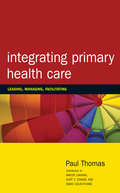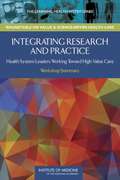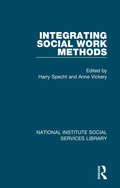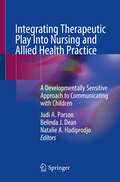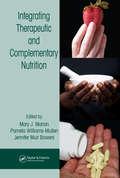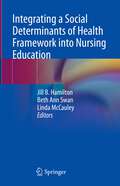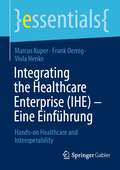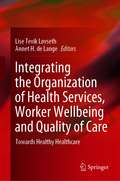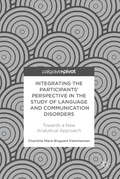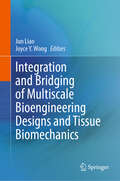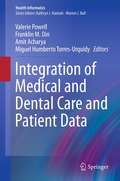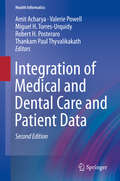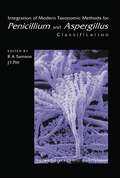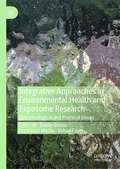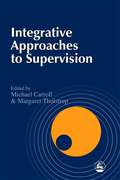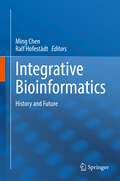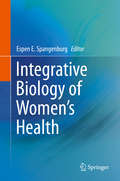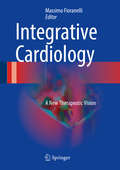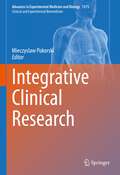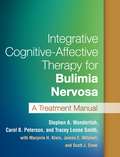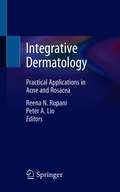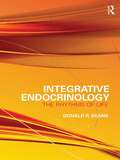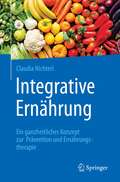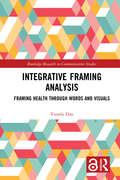- Table View
- List View
Integrating Primary Healthcare: Leading, Managing, Facilitating
by Paul ThomasThis book combines models, theory and practical advice that guides clinicians, managers and facilitators to lead integrated primary health care. Using case studies and real life examples, the practical sections are cross-referred to theoretical sections that show how theories of whole system learning and change can be applied in different situations. Exercises help the reader to devise their own tailor-made interventions in small organisations, in networks, and in large institutions. The latest theories about leadership in complex situations are covered and challenges to traditional approaches to research and understandings of health are made. This book is perfect for those who lead or teach change in health care institutions such as primary care organisations, in small organisations such as general practices, and through networks. In particular practitioners and managers who wish to make sense of complex interacting factors will find it of great benefit.
Integrating Research and Practice: Workshop Summary
by Joe AlperHealth care has been called one of the most complex sectors of the U. S. economy. Driven largely by robust innovation in treatments and interventions, this complexity has created an increased need for evidence about what works best for whom in order to inform decisions that lead to safe, efficient, effective, and affordable care. As health care becomes more digital, clinical datasets are becoming larger and more numerous. By realizing the potential of knowledge generation that is more closely integrated with the practice of care, it should be possible not only to produce more usable evidence to inform decisions, but also to increase the efficiency and decrease the costs of doing clinical research. Patient-Centered Clinical Research Network, or PCORnet, is a nation-wide patient-centered clinical research network intended to form a resource of clinical, administrative, and patient data that can be used to carry out observational and interventional research studies and enhance the use of clinical data to advance the learning health care system. The primary goal of the first phase of PCORnet will be to establish the data infrastructure necessary to do such research. In April and June 2014 the Institute of Medicine's Roundtable on Value and Science-Driven Health Care convened two workshops aimed at accelerating progress toward real-time knowledge generation through the seamless integration of clinical practice and research, one of the fundamental concepts of a continuously learning health system, centered on the development of the PCORnet. The first workshop brought together health care system leaders, both administrative and clinical, and researchers to consider issues and strategic priorities for building a successful and durable clinical research network and facilitate progress toward a continuously learning health care system more broadly, including issues related to science, technology, ethics, business, regulatory oversight, sustainability, and governance. The second workshop focused on implementation approaches. Health system CEOs convened to consider strategic priorities and explore approaches to implementation. These workshops will inform the decisions of field leaders moving forward, including PCORI, the PCORnet steering committee, and PCORnet grantees. Integrating Research and Practice is the summary of the presentations and discussions of the workshops.
Integrating Science and Politics for Public Health (Palgrave Studies in Public Health Policy Research)
by Adèle Cassola Evelyne De Leeuw Patrick FafardThis open access book bridges the divide between political science and public health, whilst simultaneously embracing the complexities and differences of both. Although public health is inherently political, the tools and insights of political science are often ignored in public health scholarship. Bringing together academics and researchers working at the intersection of both, the book demonstrates how integrating these fields can help reconcile the roles of politics and scientific evidence in policymaking. It also highlights the key conceptual, methodological and substantive implications for bridging this divide, and charts a path forward for a movement towards political science with public health. It will be of interest to academics, researchers and students interested in public health, political science, public policy, and the role of scientific evidence in policymaking.
Integrating Social Work Methods (National Institute Social Services Library)
by Harry Specht and Anne VickeryThroughout its history, social work has been seeking a means to state its purposes and methodology as a unity that transcends the purposes and methodology applicable in particular fields of practice, or sanctioned by particular legislation, or practised by a particular kind of worker. Recent changes in society, developments in social work practice, new additions to the knowledge base of social work and current reorganisation of the social services had led to an intensified interest in this ‘integrated’ approach. Originally published in 1977, Integrating Social Work Methods introduces the reader to the main developments in the conceptualisation of a unitary method. It clarifies what it is that is being unified, identifies issues involved in the attempt to unify, and discusses their implications for social work practice and training. As such it represented the first substantial British text in the field, and was widely welcomed by social work practitioners, administrators and educators at the time.
Integrating Therapeutic Play Into Nursing and Allied Health Practice: A Developmentally Sensitive Approach to Communicating with Children
by Judi A. Parson Belinda J. Dean Natalie A. HadiprodjoThis book helps support developmentally sensitive nursing and allied health practice by integrating the therapeutic powers of play into child and adolescent health care service provision. It is designed to link play, child development, neuroscience, biopsychosocial and attachment theories with the biomedical model of health. Nurses and allied health professionals work with children aged between 0-18 years and with diverse childhood illnesses, injuries, diseases, disorders, and conditions, and are therefore in a prime position to understand and support children through potentially painful and traumatic health care experiences. Understanding of the role of play and the application of the therapeutic powers of play in communicating with children and families has the potential to significantly optimise paediatric care. The theory and play based strategies, tools and techniques presented in this book assist nurses and health care professionals to engage with children in an age-appropriate manner and ‘speak’ with children through their natural language of play, to enhance comprehension, coping, resiliency, and healing. Play is recognised as a sequentially developing ability and can be aligned with the child’s age and stage of life. Play based approaches can be placed on a continuum from fully child led or non-directive play to adult facilitated educative play. Medical information can be tailored according to the various points along this continuum to inform clinical reasoning and to help children prepare for procedures, recover from medical interventions and / or make sense of their diagnosis. Whilst this book is directed at nurses and allied health professionals who work with children and their families, it may also be a valuable resource for medical and other professionals in community or educational settings to work systemically as a team. The book takes the reader on a journey to illustrate various professional and therapeutic roles in how to playfully engage children through a range of case vignettes.
Integrating Therapeutic and Complementary Nutrition
by Jennifer Muir Bowers Mary J. Marian Pamela Williams-MullenConsumers look to health professionals for guidance on how to integrate complementary and alternative (CAM) therapies into their lifestyles, yet most health care professionals are trained only in conventional practices. Integrating Therapeutic and Complementary Nutrition provides the scientific foundation necessary to understand CAM nutrition pract
Integrating a Social Determinants of Health Framework into Nursing Education
by Beth Ann Swan Jill B. Hamilton Linda McCauleyThe purpose of this ground-breaking Textbook is to describe and illustrate, with pedagogical features, the process by which social determinants of health (SDOH) has been integrated throughout all courses in the Nell Hodgson Woodruff School of Nursing. Specifically, the authors describe initial steps to develop a comprehensive SDOH model for nursing education, followed by rigorously designed faculty educational materials, exemplars of SDOH instructional materials, and evaluation of this process from faculty and students. It describes a comprehensive framework that guides the development, implementation, and evaluation of SDOH across the pre-licensure and post-licensure curriculum and illustrate the process integrating SDOH throughout all aspects of didactic, simulation, and clinical education. Among the subjects addressed, the history of nursing and SDOH and the value of SDOH content in nursing courses to alleviate health disparities are described and mandates to integrate SDOH content into nursing curriculum by the leading nursing organizations are summarized. The authors also include a review of existing SDOH frameworks used in public health and medicine and present a comprehensive SDOH model for nursing education. A SDOH educational course content for faculty is detailed (Social Determinants of Health 101) and exemplars from faculty and students are provided along with an evaluation after the first year. The authors conclude with a discussion from faculty leadership; what they learned and their suggestions to other nursing programs. Although there are books published, no books exist on this topic for nursing education and practicing nurses, yet SDOH is foundational to nursing curriculum and practice. The leading nursing organizations are all mandating that SDOH be integrated into nursing courses. Hence this textbook will be a key resource for Schools of Nursing in the US and globally. The intended audience of this book are leaders and faculty of nursing education programs, national professional nursing organizations, practicing nurses at hospitals and health systems, community and public health agencies, and ambulatory care.
Integrating the Healthcare Enterprise: Hands-on Healthcare and Interoperability (essentials)
by Frank Oemig Viola Henke Marcus KuperDieses essential bietet einen Einstieg in das Thema IHE - "Integrating the Healthcare Enterprise (IHE)“ - und hilft sowohl Einsteiger:innen als auch fortgeschrittenen "Interoperabilitätsförder:innen" dabei, zu verstehen, wie IT-Systeme in Gesundheitsunternehmen die richtigen Daten, zum richtigen Zeitpunkt sicher miteinander austauschen können und wie es IHE schafft dafür Lösungen in den verschiedenen medizinischen Domänen anzubieten.
Integrating the Organization of Health Services, Worker Wellbeing and Quality of Care: Towards Healthy Healthcare
by Lise Tevik Løvseth Annet H. de LangeThis book introduces the concept of ‘healthy healthcare’ and posits that this new concept is necessary in light of a shortage of healthcare staff in the near future. Healthy healthcare implies that healthcare systems are designed, managed and financed in balance with the available resources to improve workers’ health and performance. Ultimately, a balanced perspective taking into account the patient, the staff and the complex healthcare system will lead to a more resource-efficient delivery of high-quality healthcare services.The book synthesizes evidence-based practice and research on the links between healthcare services, employee health and wellbeing, and quality of healthcare from an interdisciplinary perspective. Written by leading experts in this rapidly expanding field of inquiry, this is the first book ever compiled on the subject with such scope and breadth. It discusses how to conduct interventions and research on healthy healthcare with different populations and settings. The chapters critically examine the links between these pillars; and identify research gaps in both methodology and content from the perspectives of psychology, medicine, nursing, economy, law, technology, management and more. This innovative book is of interest to researchers and students of health sciences, public health, health economics and allied disciplines, as well as to stakeholders in the healthcare industry.Chapter 24 of this book is available open access under a CC-By NC-ND 4.0 license at link.springer.com
Integrating the Participants’ Perspective in the Study of Language and Communication Disorders: Towards A New Analytical Approach
by Charlotte Marie Bisgaard KlemmensenThis book presents a new analytical approach that will advance the establishment of a new discourse within the study of language and communication disorders. Instances of recurring aphasia and acquired brain injury are discussed in an empirical observation study through a theoretical lens that combines Integrational Linguistics, ethnomethodology, Conversation Analysis and practice theory. In doing so, this interdisciplinary analysis adds a person-centered perspective to existing ethnographic approaches. It addresses a significant gap in our understanding of the social/communicative/interactional consequences of brain injury for everyday life by focusing on the practical problems that individuals with communication difficulties and acquired brain damage - and their care-takers, family and friends - have to solve in everyday life, and how they solve them. This innovative work will appeal to health and social care practitioners and care-givers, in addition to scholars of health communication, cognitive, psycho- and sociolinguistics.
Integration and Bridging of Multiscale Bioengineering Designs and Tissue Biomechanics
by Jun Liao Joyce Y. WongThis book covers up-to-date knowledge of how designs found in nature use tissue hierarchies to achieve optimal functions, and how these principles are applied in bioengineering. The hierarchy-based multiscale approach has the potential to drive novel biomaterial designs, advance tissue engineering and regeneration, assist in tissue-function integration, improve high-fidelity computational modeling aided by machine learning, and enhance the development of innovative characterization tools and methodologies. This book presents the latest high-impact research achievements in bioengineered and natural hierarchical systems within a clinical context. Our aim is two-fold: (i) to emphasize the importance of integrating and bridging bioengineering designs at various tissue hierarchical levels and (ii) to foster dialogue and collaboration among bioengineers, biomechanists, and clinicians.
Integration of Medical and Dental Care and Patient Data
by Valerie Powell Amit Acharya Franklin M. Din Miguel Humberto Torres-UrquidyThis book informs readers of the needs and rationale for the integration of medical and dental care and information with an international perspective as to how and where medical and dental care separated into specific domains. It provide high level guidance on issues involved with care and data integration and how to achieve an integrated model of health care supported by integrated HIT. A patient typically expects that a visit to a dentist can usually be resolved immediately. This expectation places a premium on instant, accurate, thorough, and current information. The state-of-the-art of fully integrated (dental-medical) electronic health record (EHR) is covered and this is contrasted with the current state of dental-medical software. While dentists in the US Veterans Health Administration (VHA), the US Indian Health Service (IHS), or the US military, for example, have access to fully integrated health records, most US clinicians still gather information from separate sources via fax or phone calls. The authors provide an in-depth discussion of the role of informatics and information science in the articulation of medical and dental practices and clinical data with the focus on applied clinical informatics to improve quality of care, practice efficiency, coordination and continuity of care, communication between physicians and dentists and to provide a more comprehensive care for the patients. Lastly, the book examines advances in medical and dental research and how these may affect dentistry in the future. Most new advances in healthcare research are information-intensive.
Integration of Medical and Dental Care and Patient Data (Health Informatics #3)
by Valerie Powell Amit Acharya Miguel H. Torres-Urquidy Robert H. Posteraro Thankam Paul ThyvalikakathThis largely revised second edition comprehensively reviews the need and rationale for the integration of medical and dental patient data. The reader will find extensive guidance on issues involved with care and data integration, and how to achieve an integrated model of healthcare. The book discusses how the use of state-of-the-art, fully integrated (dental-medical), electronic health records can improve clinical, financial as well as societal outcomes. In the book you will also find different aspects that play a role in integration including existing clinical software implementations (and their paths for integration), clinical touch points, and how current and future developments will facilitate the integration process in a more efficient way. This second edition of Integration of Medical and Dental Care and Patient Data details the available methods and technologies for successfully integrating patient medical and dental data. It is, therefore, an important and timely update for informaticians and a broad range of both dental and medical professionals and other health professionals (dental assistants, hygienists, nurses) as well as clinical students entering the professional environment.
Integration of Modern Taxonomic Methods For Penicillium and Aspergillus Classification
by John I. Pitt Robert A. SamsonMany species of penicillium and aspergillus are important in biotechnology, food, medicine, biodeterioration and other applied fields, so a practical and stable taxonomy is of vital importance. Recent developments in science and technology mean that taxonomic classification is no longer confined to classical morphological concepts, and the integrat
Integrative Approaches in Environmental Health and Exposome Research: Epistemological and Practical Issues
by Élodie Giroux Francesca Merlin Yohan FayetResearch on the relationship between health and the environment in a postgenomic context is increasingly aimed at understanding the various exposures as a whole, simultaneously taking into account data pertaining to the biology of organisms and the physical and social environment. Exposome research is a paradigmatic case of this new trend in environmental health studies. This book takes a multidisciplinary approach focusing on the conceptual, epistemological, and sociological reflections in the latest research on environmental and social determinants of health and disease. It offers a combination of theoretical and practical approaches and the authors are scholars from a multidisciplinary background (epidemiology, geography, philosophy of medicine and biology, sociology). Crucially, the book balances the benefit and cost of the integration of biological and social factors when modelling aetiology of disease.
Integrative Approaches to Supervision
by Charlotte Sills Michael Carroll Martin Milton Vanja Orlans Jane Speedy Brigid Proctor Penny Henderson Dagmar Edwards John Towler Jane Rosoman Maxine Dennis Rita Arundale Joanne Beazley-Richards Julie Hewson Val Wosket Harbrinder Dhillon-Stevens Graham Curtis Jenkins Margaret TholstrupAs new techniques and approaches to supervision attract interest within therapy-related professions, the contributors to this informative book consider the nature of a supervision and examine the ways in which it can be further defined and developed. Drawing together practical and theoretical perspectives, Integrative Approaches to Supervision examines the contribution that supervision can make within both organisational and individual settings. The book covers frameworks and models for supervision, supervision in clinical practice and issues within integrative supervision. Topics include: different models of the supervision practice; anti-oppressive practice; spirituality and supervision; counselling supervision in health care; supervision of organisations; self-protection for supervisors from complaints and litigation. Wide in scope but rich in detail, this book is essential reading for psychotherapists, counsellors, consultants and students involved in the supervision process.
Integrative Bioinformatics: History and Future
by Ming Chen Ralf HofestädtThis book provides an overview of the history of integrative bioinformatics and the actual situation and the relevant tools. Subjects cover the essential topics, basic introductions, and latest developments; biological data integration and manipulation; modeling and simulation of networks; as well as a number of applications of integrative bioinformatics. It aims to provide basic introduction of biological information systems and guidance for the computational analysis of systems biology. This book covers a range of issues and methods that unveil a multitude of omics data integration and relevance that integrative bioinformatics has today. It contains a unique compilation of invited and selected articles from the Journal of Integrative Bioinformatics (JIB) and annual meetings of the International Symposium on Integrative Bioinformatics.
Integrative Biology of Women's Health
by Espen E. SpangenburgDefining and understanding cellular and molecular mechanisms that are relevant to women's health has become a critical area of scientific pursuit. Until recently, very little effort has been place on defining or understanding critical differences between women and men that may be critical to the overall health of the woman. In 1990, the National Institutes of Health recognized this gap in knowledge resulting in the creation of the Office of Research on Women's Health. One of the purposes of this office was to advance the understanding of health issues from the women's perspective from both a basic and clinical scientific perspective. From a scientific evolution of understanding, the existence of this office is new and thus there has not been enough time for new information to integrate itself in our current scientific thought process. This book will seek to capture and disseminate our current understanding of scientific advancements relevant to women's health and provide the information to a broad audience. The purpose of this work is to discuss recent advancements in basic science across three areas of concern for women's health. In addition, the book will provide "translational" chapters that attempt to place the basic science work in context within our current understanding of the human. Although it is well acknowledge that gender differences exist across organ function which translates into differences in whole body function, until recently little effort has been made to define basic mechanisms within various tissues within the woman. This work will focus on recent scientific findings that are relevant to women's health and to provide novel and relevant information to interested scientists and clinicians.
Integrative Cardiology
by Massimo FioranelliThis book is a detailed guide to a new integrative approach to the prevention and treatment of various cardiac disorders and risk factors, including coronary artery disease, congestive heart failure, arrhythmias, dyslipidemia, and hypertension. This approach combines various strategies, including metabolic cardiology, low-dose medicine, exercise programs, stress management programs, evaluation for inherited risk factors, and various other healing modalities. Metabolic cardiology focuses on the prevention, management, and treatment of cardiovascular disease at the cellular level through biochemical interventions with nutritional supplements that can promote energy production in the heart. Low-dose medicine, on the other hand, interprets pathological phenomena as an imbalance in intercellular signaling that may be corrected through the administration of low physiological doses of messenger molecules. Therapies outside of mainstream medicine may also be deployed in integrative cardiology, for example acupuncture, herbal medicine, and homeopathy. Integrative Cardiology will be of interest to all practitioners wishing to learn about an approach that incorporates the incredible advances in medication and technology with a focus on nutrition, lifestyle, and mind-body influences.
Integrative Clinical Research (Advances in Experimental Medicine and Biology #1375)
by Mieczyslaw PokorskiThis book embraces a comprehensive range of research across several disciplines, providing insights and fresh perspectives on clinical topics, emphasizing the integrative medical approach. The book also addresses an increasing role of artificial intelligence in the development of clinical methodologies, research, and patient-oriented care. The authors share expertise and experience in rehabilitation medicine whose healing-effects particularly depend on the interaction between the therapist and patient. Chapters present novel approaches in manual rehabilitative therapy of common painful and disabling neuromuscular ailments, exemplified but not limited to low back pain and migraine. The myofascial trigger point release therapy includes specific manipulations to muscles and connective tissue which reduce pain. Other chapters address the issues of providing long-range medical care to older adults burdened with chronic diseases, notably hypoxia-related pathologies and their sequalae, pointing to the advantages of care provided by a single primary care physician. Changing paradigm of care is essential in chronic atherosclerosis-based diseases like cardiovascular disorders or diabetes. Chapters provide results of international cohort studies on predictive factors for the long-range progress of such ailments based on anthropometric and lifestyle indicators. The book aims to meet the increasing interest and importance to patients of integrative health therapies. Medical rehabilitation and lifestyle changes increasingly gain scientific support in difficult-to-treat chronic conditions and should be integrated in a controlled manner into conventional medicine. The book is addressed to physiotherapists, medical scientists and clinicians, and allied healthcare professionals.
Integrative Cognitive-Affective Therapy for Bulimia Nervosa
by PhD Carol B. Peterson James E. Mitchell Tracey Leone Smith Scott J. Crow Stephen A. Wonderlich Marjorie H. KleinPacked with useful clinical tools, this state-of-the-art manual presents an empirically supported treatment solidly grounded in current scientific knowledge. Integrative cognitive-affective therapy for bulimia nervosa (ICAT-BN) has a unique emphasis on emotion. Interventions focus on helping clients understand the links between emotional states and BN as they work to improve their eating behaviors, defuse the triggers of bulimic episodes, and build crucial emotion regulation skills. In a large-size format for easy photocopying, the book includes 47 reproducible handouts. Purchasers get access to a Web page where they can download and print the reproducible materials.
Integrative Dermatology: Practical Applications in Acne and Rosacea (Integrative Medicine Library)
by Peter A. Lio Reena N. RupaniThis book offers the most up-to-date and evidence-based information surrounding integrative treatments for acne and rosacea. Ranging from topical solutions, to nutrition, to mind-body medicine, each chapter addresses evidence for use and patient outcomes. Discussions regarding oral and topical botanical supplements and dietary modifications are complemented by the examination of non-Western healing systems' approach to acne and rosacea. Backed by clinical evidence, chapters feature real patient outcomes with complete explanations of the viability of the treatment. Concise and unique, Integrative Dermatology: Practical Applications in Acne and Rosacea, is an invaluable text for not only the dermatologist, but the pediatrician, family practitioner, internist, and holistic/alternative provider.
Integrative Endocrinology: The Rhythms of Life
by Donald R BeansThis book explains the treatment of endocrine disorders using natural therapies. Donald Beans provides the reader with everything there is to know to treat endocrine disorders without hormones. This book outlines the function of the endocrine glands and the testing of their function including clinical laboratory evaluation and bedside diagnosis. This is the first book to include the entire endocrine system and many natural therapies in one text, thus allowing the practitioner an unprecedented insight into endocrine treatment. Integrative Endocrinology discusses, in depth, the fundamental philosophical difference between hormone replacement therapy and integrative endocrinology. Natural therapies include acupuncture, gland cell therapy, homeopathy, herbal medicine, and a number of other methods. This book is of great value to health professionals, students and scholars in integrative medicine, alternative medicine and endocrinology. It is also valuable as a self help handbook for the motivated non-professional.
Integrative Ernährung: Ein ganzheitliches Konzept zur Prävention und Ernährungstherapie
by Claudia NichterlIntegrative Ernährung kombiniert die Ernährungswissenschaft mit traditionellen medizinischen Systemen. Sie bietet ein seriöses Fundament für individuelle Ernährungsempfehlungen, die praxisnah und nachhaltig sind. Das Buch stellt die integrative Ernährungstherapie als ganzheitliches Konzept für die Prävention und Gesunderhaltung, aber auch als komplementäre Unterstützung zur Behandlung von Zivilisationskrankheiten, wie etwa Übergewicht, Allergien und/oder Unverträglichkeiten, Reizdarm, chronisch entzündlichen Darmerkrankungen, Autoimmunerkrankungen vor. Der erste Teil behandelt die Grundlagen und die wesentlichen Prinzipien der Traditionellen Chinesischen Medizin (TCM) im Vergleich zur klassischen Ernährungswissenschaft und Ernährungsmedizin. Im zweiten Teil werden die Vorteile der Integrativen Ernährung anhand von häufigen Beschwerde- und Krankheitsbildern beleuchtet. Im dritten und letzten Teil wird ein Ausblick auf die Einsatzmöglichkeiten gegeben. Das Buch richtet sich an Ärzte und Therapeuten, wie sie mit punktgenauen Tipps und Maßnahmen den Therapieerfolg ihrer Patienten unterstützen können, darüber hinaus schätzen auch Konsumenten die Hinweise zur Selbsthilfe.
Integrative Framing Analysis: Framing Health through Words and Visuals (Routledge Research in Communication Studies)
by Viorela DanMuch of framing scholarship focuses either exclusively on the analysis of words or of visuals. This book aims to address this gap by proposing a six-step approach to the analysis of verbal frames, visual frames and the interplay between them—an integrative framing analysis. This approach is then demonstrated through a study investigating the way words and visuals are used to frame people living with HIV/AIDS in various communication contexts: the news, public service announcements and special interest publications. This application of integrative framing analysis reveals differences between verbal frames and visual frames in the same messages, underscoring the importance of looking at these frames together.
